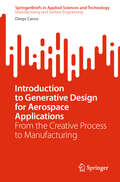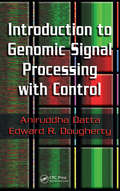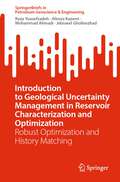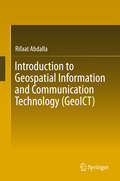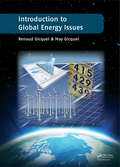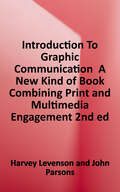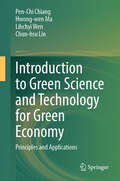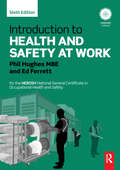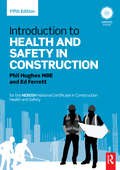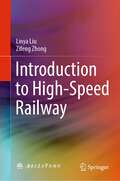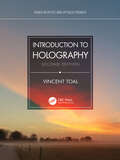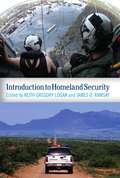- Table View
- List View
Introduction to Generative Design for Aerospace Applications: From the Creative Process to Manufacturing (SpringerBriefs in Applied Sciences and Technology)
by Diego CarouThis book provides a comprehensive introduction to generative design in the aerospace sector, guiding readers from initial creative concepts to the final stages of manufacturing. It offers a thorough exploration of sustainable production methods, cutting-edge technological advancements, and the principles of generative design. With a focus on artificial intelligence's role in optimizing design and manufacturing, this book also delves into topology optimization, offering valuable insights for both newcomers and experienced professionals in the field. Through practical examples and a structured approach, readers will gain a solid understanding of the innovations shaping the future of aerospace design.
Introduction to Genomic Signal Processing with Control
by Edward R. Dougherty Aniruddha DattaStudying large sets of genes and their collective function requires tools that can easily handle huge amounts of information. Recent research indicates that engineering approaches for prediction, signal processing, and control are well suited for studying multivariate interactions. A tutorial guide to the current engineering research in genomics, Introduction to Genomic Signal Processing with Control provides a state-of-the-art account of the use of control theory to obtain intervention strategies for gene regulatory networks. The book builds up the necessary molecular biology background with a basic review of organic chemistry and an introduction of DNA, RNA, and proteins, followed by a description of the processes of transcription and translation and the genetic code that is used to carry out the latter. It discusses control of gene expression, introduces genetic engineering tools such as microarrays and PCR, and covers cell cycle control and tissue renewal in multi-cellular organisms.The authors then delineate how the engineering approaches of classification and clustering are appropriate for carrying out gene-based disease classification. This leads naturally to expression prediction, which in turn leads to genetic regulatory networks. The book concludes with a discussion of control approaches that can be used to alter the behavior of such networks in the hope that this alteration will move the network from a diseased state to a disease-free state.Written by recognized leaders in this emerging field, the book provides the exact amount of molecular biology required to understand the engineering applications. It is a self-contained resource that spans the diverse disciplines of molecular biology and electrical engineering.
Introduction to Geological Uncertainty Management in Reservoir Characterization and Optimization: Robust Optimization and History Matching (SpringerBriefs in Petroleum Geoscience & Engineering)
by Jebraeel Gholinezhad Reza Yousefzadeh Alireza Kazemi Mohammad AhmadiThis book explores methods for managing uncertainty in reservoir characterization and optimization. It covers the fundamentals, challenges, and solutions to tackle the challenges made by geological uncertainty. The first chapter discusses types and sources of uncertainty and the challenges in different phases of reservoir management, along with general methods to manage it. The second chapter focuses on geological uncertainty, explaining its impact on field development and methods to handle it using prior information, seismic and petrophysical data, and geological parametrization. The third chapter deals with reducing geological uncertainty through history matching and the various methods used, including closed-loop management, ensemble assimilation, and stochastic optimization. The fourth chapter presents dimensionality reduction methods to tackle high-dimensional geological realizations. The fifth chapter covers field development optimization using robust optimization, including solutions for its challenges such as high computational cost and risk attitudes. The final chapter introduces different types of proxy models in history matching and robust optimization, discussing their pros and cons, and applications. The book will be of interest to researchers and professors, geologists and professionals in oil and gas production and exploration.
Introduction to Geometric Control (Springer Optimization and Its Applications #192)
by Yuri SachkovThis text is an enhanced, English version of the Russian edition, published in early 2021 and is appropriate for an introductory course in geometric control theory. The concise presentation provides an accessible treatment of the subject for advanced undergraduate and graduate students in theoretical and applied mathematics, as well as to experts in classic control theory for whom geometric methods may be introduced. Theory is accompanied by characteristic examples such as stopping a train, motion of mobile robot, Euler elasticae, Dido's problem, and rolling of the sphere on the plane. Quick foundations to some recent topics of interest like control on Lie groups and sub-Riemannian geometry are included. Prerequisites include only a basic knowledge of calculus, linear algebra, and ODEs; preliminary knowledge of control theory is not assumed. The applications problems-oriented approach discusses core subjects and encourages the reader to solve related challenges independently. Highly-motivated readers can acquire working knowledge of geometric control techniques and progress to studying control problems and more comprehensive books on their own. Selected sections provide exercises to assist in deeper understanding of the material.Controllability and optimal control problems are considered for nonlinear nonholonomic systems on smooth manifolds, in particular, on Lie groups. For the controllability problem, the following questions are considered: controllability of linear systems, local controllability of nonlinear systems, Nagano–Sussmann Orbit theorem, Rashevskii–Chow theorem, Krener's theorem. For the optimal control problem, Filippov's theorem is stated, invariant formulation of Pontryagin maximum principle on manifolds is given, second-order optimality conditions are discussed, and the sub-Riemannian problem is studied in detail. Pontryagin maximum principle is proved for sub-Riemannian problems, solution to the sub-Riemannian problems on the Heisenberg group, the group of motions of the plane, and the Engel group is described.
Introduction to Geometrically Nonlinear Continuum Dislocation Theory: FE Implementation and Application on Subgrain Formation in Cubic Single Crystals Under Large Strains (SpringerBriefs in Applied Sciences and Technology)
by Christian B. Silbermann Matthias Baitsch Jörn IhlemannThis book provides an introduction to geometrically non-linear single crystal plasticity with continuously distributed dislocations. A symbolic tensor notation is used to focus on the physics. The book also shows the implementation of the theory into the finite element method. Moreover, a simple simulation example demonstrates the capability of the theory to describe the emergence of planar lattice defects (subgrain boundaries) and introduces characteristics of pattern forming systems. Numerical challenges involved in the localization phenomena are discussed in detail.
Introduction to Geophysical Formation Evaluation
by James K. HallenburgThese three works cover the entire field of formation evaluation, from basic concepts and theories, through standard methods used by the petroleum industry, on to new and exciting applications in environmental science and engineering, hydrogeology, and other fields. Designed to be used individually or as a set, these volumes represent the first comprehensive assessment of all exploration methodologies. No other books offer the breadth of information and range of applications available in this set.The first volume, Introduction to Geophysical Formation Evaluation, is the perfect introductory reference for environmental professionals without previous training in the field. It explains the fundamentals of geophysical exploration and analysis, illuminates the underlying theories, and offers practical guidance on how to use the available methodologies. General information on material behavior, porosity, tortuosity, permeability, cores, resistivity, radioactivity, and more provides a solid foundation for more advanced studies.The second volume, Standard Methods of Geophysical Formation Evaluation builds on the basic precepts presented in the first work but can be used alone as a self-contained reference. It covers all the petroleum-oriented standard methods which, until recently, have comprised the majority of applications of geophysical formation evaluation. It also points out non-hydrocarbon uses of petroleum methods. This volume provides complete practical information and instructions on using the standard exploration and evaluation methods. It presents comprehensive, painstakingly detailed instructions for resistivity, radiation, and acoustic methods.The third volume, Non-Hydrocarbon Methods of Geophysical Formation Evaluation, discusses uses of formation evaluation in environmental science and engineering, hydrogeology, and other fields outside the petroleum industry, and demonstrates how the standard methods can be adapted to these non-hydrocarbon purpos
Introduction to Geospatial Information and Communication Technology (GeoICT)
by Rifaat AbdallaThis book is designed to help students and researchers understand the latest research and development trends in the domain of geospatial information and communication (GeoICT) technologies. Accordingly, it covers the fundamentals of geospatial information systems, spatial positioning technologies, and networking and mobile communications, with a focus on OGC and OGC standards, Internet GIS, and location-based services. Particular emphasis is placed on introducing GeoICT as an integrated technology that effectively bridges various information-technology domains.
Introduction to Global Energy Issues
by Renaud Gicquel May GicquelFrom the discovery of fire to that of the atom, the development of human societies has largely been based on the conquest of energy. In all countries, energy has gradually become one of the key factors of social and economic development, as well as capital, labor and natural resources, and now no one can do without it. After decades of cheap energy
Introduction to Graphene-based Nanomaterials
by Luis E. F. Foa TorresBeginning with an introduction to carbon-based nanomaterials, their electronic properties, and general concepts in quantum transport, this detailed primer describes the most effective theoretical and computational methods and tools for simulating the electronic structure and transport properties of graphene-based systems. Transport concepts are clearly presented through simple models, enabling comparison with analytical treatments, and multiscale quantum transport methodologies are introduced and developed in a straightforward way, demonstrating a range of methods for tackling the modelling of defects and impurities in more complex graphene-based materials. The authors also discuss the practical applications of this revolutionary nanomaterial, contemporary challenges in theory and simulation, and long-term perspectives. Containing numerous problems for solution, real-life examples of current research, and accompanied online by further exercises, solutions and computational codes, this is the perfect introductory resource for graduate students and researchers in nanoscience and nanotechnology, condensed matter physics, materials science and nanoelectronics.
Introduction to Graphic Communication: A New Kind of Book, Combining Print and Multimedia Engagement
by John Parsons Harvey LevensonThis book is a survey of the complex world of graphic communication. It is focused largely on print, both conventional and digital, and the processes that make it possible. It is also about the myriad ways digital technology from desktop design to web-based publishing, commerce, and IT affects the art, science, and business of printing.
Introduction to Green Chemistry
by John Andraos Albert S. MatlackInterest in green chemistry and clean processes has grown so much in recent years that topics such as fluorous biphasic catalysis, metal organic frameworks, and process intensification, which were barely mentioned in the First Edition, have become major areas of research. In addition, government funding has ramped up the development of fuel cells and biofuels. This reflects the evolving focus from pollution remediation to pollution prevention. Copiously illustrated with more than 800 figures, the Third Edition provides an update from the frontiers of the field. It features supplementary exercises at the end of each chapter relevant to the chemical examples introduced in each chapter. Particular attention is paid to a new concluding chapter on the use of green metrics as an objective tool to demonstrate proof of synthesis plan efficiency and to identify where further improvements can be made through fully worked examples relevant to the chemical industry. NEW AND EXPANDED RESEARCH TOPICS Metal-organic frameworks Metrics Solid acids for alkylation of isobutene by butanes Carbon molecular sieves Mixed micro- and mesoporous solids Organocatalysis Process intensification and gas phase enzymatic reactions Hydrogen storage for fuel cells Reactive distillation Catalysts in action on an atomic scale UPDATED AND EXPANDED CURRENT EVENTS TOPICS Industry resistance to inherently safer chemistry Nuclear power Removal of mercury from vaccines Removal of mercury and lead from primary explosives Biofuels Uses for surplus glycerol New hard materials to reduce wear Electronic waste Smart growth The book covers traditional green chemistry topics, including catalysis, benign solvents, and alternative feedstocks. It also discusses relevant but less frequently covered topics with chapters such as "Chemistry of Long Wear" and "Population and the Environment." This coverage highlights the importance of chemistry to everyday life and demonstrates the benefits the expanded exploitation of green chemistry can have for society.
Introduction to Green Science and Technology for Green Economy: Principles and Applications
by Pen-Chi Chiang Hwong-wen Ma Lihchyi Wen Chun-hsu LinThis book focused specifically on the newly emerging issues related to the development of green science/technology, and green economy toward Sustainable Development Goals (SDGs). It covers three parts, namely (1) socioeconomic science, (2) environmental science, and (3) development of green technology and economy, each consisting of five to six chapters. The topics covered are meant not only to introduce the basic concepts of green science and technology related to the development of green economy, but also address the challenges, policy instruments, international initiatives and prospective and perspective. More importantly, it presents several innovative idea, indicators and methodologies regarding the measurement of industrial transformation, resource efficiency, green competitiveness, and green trade. To facilitate research innovation/integration and meet the needs for comprehensive education on sustainable development, the book covers a wide range of sectors of major concern in the development of green technology and economy, including green energy, green transportation, green building, green agriculture, and green tourism. The book also features innovation technology and integrated management pervasively adopted worldwide and several unanimous case studies. This book serves a wide range of readers from students, researchers, engineers, policy makers, and entrepreneurs with the emerging challenges, new concepts, innovative methodologies, and integrated strategies it provides. The insights shared from the case studies are also illustrative and inspiring.
Introduction to Ground Penetrating Radar
by Raffaele PersicoThis book presents a comprehensive treatment of ground penetrating radar using both forward and inverse scattering mathematical techniques. Use of field data instead of laboratory data enables readers to envision real-life underground imaging; a full color insert further clarifies understanding. Along with considering the practical problem of achieving interpretable underground images, this book also features significant coverage of the problem's mathematical background. This twofold approach provides a resource that will appeal both to application oriented geologists and testing specialists, and to more research-oriented physicists and engineers.
Introduction to Hamiltonian Dynamical Systems and the N-Body Problem
by Kenneth R. Meyer Daniel C. OffinThis third edition text provides expanded material on the restricted three body problem and celestial mechanics. With each chapter containing new content, readers are provided with new material on reduction, orbifolds, and the regularization of the Kepler problem, all of which are provided with applications. The previous editions grew out of graduate level courses in mathematics, engineering, and physics given at several different universities. The courses took students who had some background in differential equations and lead them through a systematic grounding in the theory of Hamiltonian mechanics from a dynamical systems point of view.This text provides a mathematical structure of celestial mechanics ideal for beginners, and will be useful to graduate students and researchers alike. Reviews of the second edition:"The primary subject here is the basic theory of Hamiltonian differential equations studied from the perspective of differential dynamical systems. The N-body problem is used as the primary example of a Hamiltonian system, a touchstone for the theory as the authors develop it. This book is intended to support a first course at the graduate level for mathematics and engineering students. … It is a well-organized and accessible introduction to the subject … . This is an attractive book … ." (William J. Satzer, The Mathematical Association of America, March, 2009) “The second edition of this text infuses new mathematical substance and relevance into an already modern classic … and is sure to excite future generations of readers. … This outstanding book can be used not only as an introductory course at the graduate level in mathematics, but also as course material for engineering graduate students. … it is an elegant and invaluable reference for mathematicians and scientists with an interest in classical and celestial mechanics, astrodynamics, physics, biology, and related fields.” (Marian Gidea, Mathematical Reviews, Issue 2010 d)
Introduction to Hardware Security and Trust
by Cliff Wang Mohammad TehranipoorThis book provides the foundations for understanding hardware security and trust, which have become major concerns for national security over the past decade. Coverage includes security and trust issues in all types of electronic devices and systems such as ASICs, COTS, FPGAs, microprocessors/DSPs, and embedded systems. This serves as an invaluable reference to the state-of-the-art research that is of critical significance to the security of, and trust in, modern society's microelectronic-supported infrastructures.
Introduction to Hazard Control Management: A Vital Organizational Function
by James T. TweedyThe International Board for the Certification of Safety Managers (IBFCSM) has designated this text as the Primary Study Reference for those preparing to sit for the Certified Hazard Control Manager (CHCM) and the Certified Hazard Control Manager-Security (CHCM-SEC) Examinations. Introduction to Hazard Control Management: A Vital Organizational Func
Introduction to Health and Safety at Work: for the NEBOSH National General Certificate in Occupational Health and Safety
by Phil Hughes Ed FerrettIntroduction to Health and Safety at Work covers the fundamentals of occupational safety and health for the thousands of students who complete the NEBOSH National General Certificate in Occupational Health and Safety each year. Fully revised in alignment with the April 2015 syllabus, this sixth edition provides students with all they need to tackle the course with confidence. The highly illustrated content covers all of the essential elements of health and safety management, the legal framework, risk assessment and control standards and also includes checklists, report forms and record sheets to supplement learning. Aligned to the NEBOSH National General Certificate in Occupational Health and Safety Practice questions and answers to test knowledge and increase understanding Complete with a companion website containing extra resources for tutors and students at www.routledge.com/cw/hughes Written by renowned authors, the Introduction to Health and Safety at Work is also a handy reference for managers and directors dealing with the day-to-day issues of health and safety and is of great value to those studying for level 3 N/SVQ and the NEBOSH National Diploma.
Introduction to Health and Safety at Work: for the NEBOSH National General Certificate in Occupational Health and Safety
by Ed Ferrett Phil Hughes MBEIntroduction to Health and Safety at Work covers the fundamentals of occupational safety and health for the thousands of students who complete the NEBOSH National General Certificate in Occupational Health and Safety each year. This seventh edition closely follows the NEBOSH National General Certificate syllabus which was updated in 2019 and comes into use in 2020. The highly illustrated content covers all of the essential elements of health and safety management, the legal framework, risk assessment and control standards and also includes checklists, report forms and record sheets to supplement learning. It also has an extensive summary of current health and safety legislation. • Aligned to the NEBOSH National General Certificate in Occupational Health and Safety • Practice questions and answers to test knowledge and increase understanding • Complete with a companion website containing extra resources for tutors and students The book is suitable for all students following a level 3 Health and Safety course and a source of reference and guidance for managers at work in the UK. Written by renowned authors, this book is often provided as part of the Certificate course and is essential reading for a student.
Introduction to Health and Safety at Work: for the NEBOSH National General Certificate in Occupational Health and Safety
by Ed Ferrett Phil Hughes MBEIntroduction to Health and Safety at Work covers the fundamentals of occupational safety and closely follows the NEBOSH National General Certificate syllabus which was updated in 2019 and came into use in 2020.Highly illustrated and over 600 pages in length, it covers all of the essential elements of health and safety management, the legal framework, risk assessment and control standards and also includes checklists, report forms and record sheets to supplement learning. It also has an extensive summary of current health and safety legislation. Aligned to the NEBOSH National General Certificate in Occupational Health and Safety Practice questions and answers to test knowledge and increase understanding In addition to helping students study for the NGC, it is used for reference and revision on other Health and Safety qualifications at level 3 and above, including the Nebosh Diploma. It is also a source of reference and guidance for health and safety practitioners in the workplace.
Introduction to Health and Safety in Construction: for the NEBOSH National Certificate in Construction Health and Safety
by Phil Hughes Ed FerrettIntroduction to Health and Safety in Construction has been specially written for the thousands of students who complete the NEBOSH National Certificate in Construction Health and Safety each year. Fully revised in alignment with the April 2015 syllabus, the fifth edition provides students with all they need to tackle the course with confidence. The book covers all the essential elements of health and safety management in construction including the legal framework, risk assessment and control standards. Highly illustrated, with information provided in a clear, easily accessible format, it also provides checklists and record sheets to supplement learning. Aligned to the NEBOSH National Certificate in Construction Health and Safety Practice questions and answers to test knowledge and increase understanding Complete with a companion website containing extra resources for tutors and students at www.routledge.com/cw/hughes The only textbook endorsed for the NEBOSH National Certificate in Construction Health and Safety, the Introduction to Health and Safety in Construction is also suitable for construction courses in the UK and overseas and serves as a comprehensive reference for managers and professionals within the construction industry.
Introduction to Healthcare Quality Management (Gateway to Healthcare Management)
by Patrice L. SpathIntroduction to Healthcare Quality Management explains the basic principles and techniques of quality management in healthcare. Written for students and professionals with little or no clinical experience, the book focuses primarily on measuring and improving the operational and patient service aspects of healthcare delivery.
Introduction to Hierarchical Bayesian Modeling for Ecological Data (Chapman & Hall/CRC Applied Environmental Statistics)
by Eric Parent Etienne RivotMaking statistical modeling and inference more accessible to ecologists and related scientists, Introduction to Hierarchical Bayesian Modeling for Ecological Data gives readers a flexible and effective framework to learn about complex ecological processes from various sources of data. It also helps readers get started on building their own statisti
Introduction to High-Speed Railway
by Linya Liu Zifeng ZhongThis book provides a comprehensive overview of various aspects of high-speed railways, such as infrastructure, communication signals, traction power supply, trainsets, and transportation organization. It delves into the basic concepts, fundamental theories, and the latest technological achievements in these areas, equipping readers with a strong foundation in the subject matter. The content is organized into eight chapters: Introduction, High-Speed Railway Lines and Infrastructure, Power Supply Systems, High-Speed Railway Trainsets, Signal and Communication Systems, Transportation Organization, Passenger Services, and Maglev Railways. Each chapter explores different facets of high-speed railway systems, focusing on the unique characteristics, design principles, and operational methodologies that set them apart from traditional railway systems. The book also highlights recent breakthroughs and innovations in the field, giving readers a glimpse of the future potential of high-speed railways. The book is tailored to meet the needs of undergraduate and graduate students pursuing degrees in railway transportation, railway engineering, locomotive vehicles, electrical traction, signal communication, and related fields. It offers a systematic and in-depth understanding of high-speed railway systems, enabling students to grasp the subject matter and apply their knowledge to real-world situations. It can also be a training material for railway professionals looking to expand their knowledge and skills in high-speed railway systems. Furthermore, the book can be a useful reference for postgraduate students engaged in research in relevant fields. It offers a wealth of information and insights, assisting researchers in understanding the intricacies of high-speed railway systems, and exploring new avenues for innovation and improvement.
Introduction to Holography (Series in Optics and Optoelectronics)
by Vincent ToalThis fully updated second edition of Introduction to Holography provides a theoretical background in optics and holography with a comprehensive survey of practical applications. It is intended for the non-specialist with an interest in using holographic methods in research and engineering. The text assumes some knowledge of electromagnetism, although this is not essential for an understanding of optics, which is covered in the first two chapters. A descriptive approach to the history and principles of holography is followed by a chapter on volume holography. Essential practical requirements for successful holographic recording are explained in detail. Recording materials are considered with detailed discussions of those in common use. Properties peculiar to holographically reconstructed images are emphasised as well as applications for which holography is particularly suitable. Mathematical tools are introduced as and when required throughout the text with important results derived in detail. In this new edition, topics such as photopolymers, dynamic holographic displays, holographic optical elements, sensors, and digital holography are covered in greater depth. New topics have been added, including UV and infrared holography, holographic authentication and encryption, as well as particle beam, X-ray, and acoustic holography. Numerical problems are provided at the end of each chapter. This book is suitable for undergraduate courses and will be an important resource for those teaching optics and holography. It provides scientists and engineers with knowledge of a wide range of holographic applications in research and industry, as well as an understanding of holography’s potential for future use.
Introduction to Homeland Security
by Keith Gregory Logan James D. RamsayThis book introduces students to the dynamic and complex enterprise that is homeland security. Using a broad lens, the authors explore key operational and content areas, as well as the practices and policies that are part of an effective homeland security program. With original essays from academics and practitioners, the book encapsulates the breadth of homeland security as it exists today. Topical coverage includes: administration, intelligence, critical infrastructure protection, emergency management, terrorism and counterterrorism, law and policy, technology and systems, strategic planning, strategic communication, civil-military affairs, private sector involvement, environmental security, and public health. Accessible, engaging, and comprehensive, this is an essential resource for courses on homeland security.
